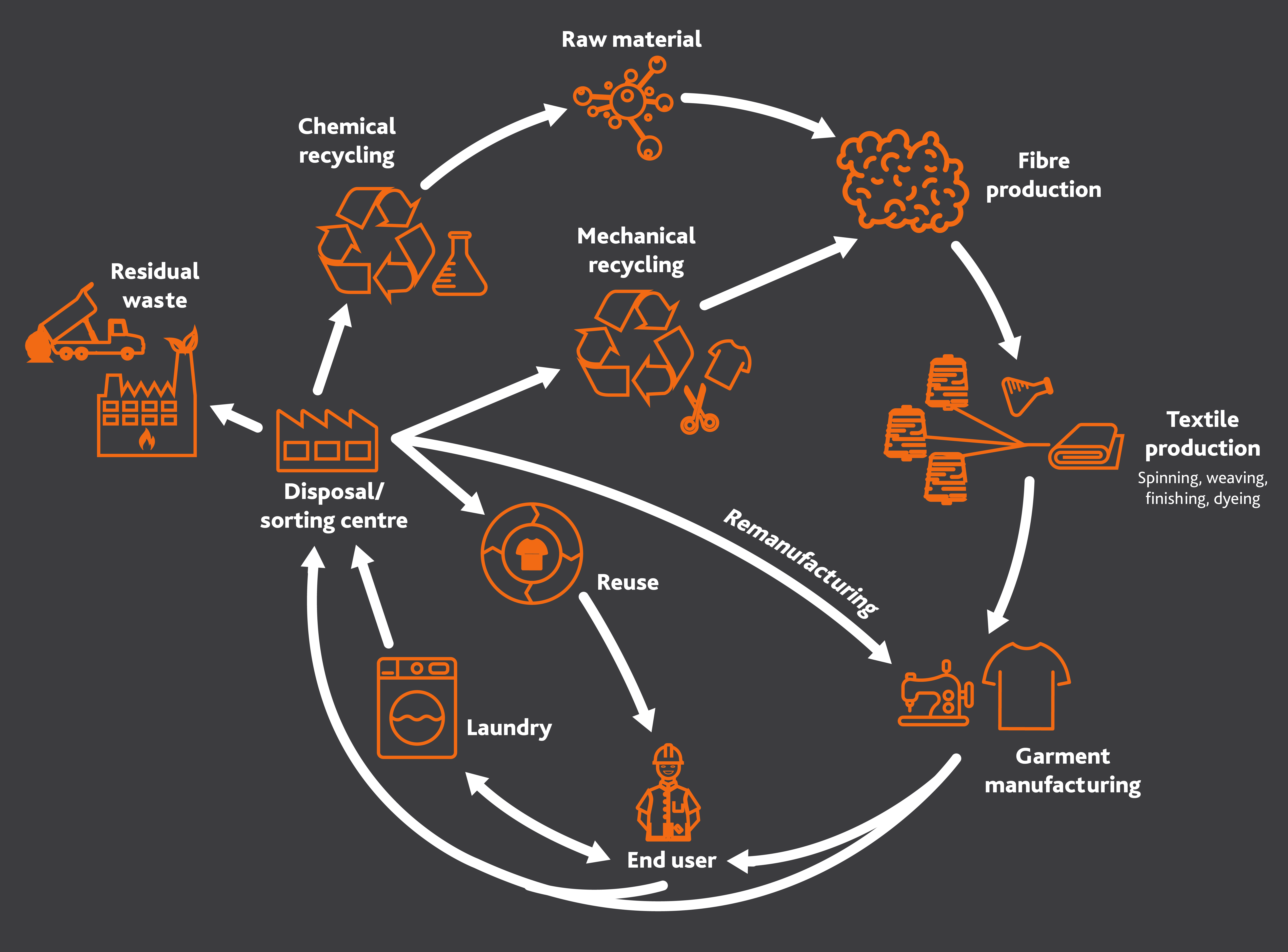Within the textile industry, circular workwear is becoming a necessity. As sustainability continues to move up in our industry’s priorities, there are specific goals we must work towards achieving. Let’s dive into what circularity means and why it is an essential component in the future of the protective clothing industry.
What’s the difference between sustainable and circular workwear?
First things first, it's important to differentiate between the terms ‘sustainability’ and ‘circularity.’
- Sustainability is defined as development that meets the needs of current generations without compromising the ability of future generations to meet their own needs.
- Circularity refers to extending the service life of a product through reuse, repair, remanufacture, and recycling.
Both sustainability and circularity play essential roles in creating protective workwear that has less impact on our environment.
In designing circular protective workwear, the aim is to develop materials that can be reclaimed at the end of the garment's life by recovering the fiber material, creating a closed loop. This design principle is at the core of the principles of circularity. Our goal is to incorporate more renewable materials. These are materials that can either be recycled and reused at the end of a product’s life, or that biodegrade and can be regrown. Work is ongoing with our partners to develop the technology and create a truly closed loop process.
Why is circular workwear becoming a necessity?
Currently, nonrenewable resources are being depleted at a rapid rate. Therefore, we must pursue alternatives that can feed into a closed loop circular system, instead of the traditional take make waste model.
The textiles industry has the fourth highest impact when it comes to pollution, due to discarded garments and the use of unsustainable raw materials. The textile industry therefore needs to be responsive and avoid waste. In Europe, the EU textile strategy has been established in response to the United Nation's Sustainable Development Goals (UN SDGs) and sets out guidelines for the production and consumption of textiles. Textile producers must be responsible for creating durable, repairable, and recyclable designs with a significant proportion of recycled material fibers produced in a manner that respects social rights and the environment.
How does circularity benefit the workwear textiles industry?
We understand that circularity contributes to the aims of the UN SDGs, thereby benefiting our planet. But what added value does it provide within the workwear textile industry? By repairing, reusing, and repurposing circular textiles, you maximize the life of your fabrics and thus reduce the amount of new materials you need to purchase. This keeps costs down, which is a huge benefit in the long run. Above all, textile waste is a significant problem in the textile industry, but employing circular workwear will greatly contribute to combatting this.
What workwear fabrics can be recycled currently?
There are two methods for the circular management of workwear fabrics: mechanical and chemical recycling.
- Mechanical recycling
In mechanical recycling, workwear fabrics are shredded and fiber bundles are opened up. The recycled fiber content can then be spun again by blending it with virgin carriers. Within the workwear industry, we prefer to work with recycled fiber content regenerated from synthetic textiles, like polyester rich, nylon, or aramid based fabrics. These end of life textiles are stronger and more able to withstand mechanical shredding processes, as opposed to natural fibers, like cotton.
It's a fact that the quality output of recycled fibers always decreases. But synthetics maintain better fiber lengths after recycling. This is ideal for designing new fabrics that can withstand the frequent industrial launderings that are essential in maintaining workwear garments. When it comes to mechanical recycling, we can define what comes out; but it is difficult to separate blends or to decolorize. - Chemical recycling
In chemical recycling, fibers are dissolved, melted, and depolymerized into smaller molecules. Then, they are rebuilt to form new textile fibers. It is a process that is currently being deployed for cellulose based and nylon based textiles. For these feedstocks, it is not a future long term solution; and for workwear rich in polyester, modacrylic, or aramid fibers, chemical recycling technology will take several more years to develop. Nevertheless, it is a process that is on our technology roadmap and will require continued investment and innovation.
In workwear fabric production, we inevitably work with fiber blends, dyes, and customized finishes to give them the suitable properties required of protective workwear. The need for these specialized characteristics makes it more challenging to be 100% circular with workwear within the limitations of mechanical and chemical recycling processes. But even as our industry works to innovate toward greater circular management, these current processes can help us reduce waste now.

The Current Industry Focus
Currently, the workwear industry mainly focuses on the circularity of white workwear from the healthcare and food industries. This is for several reasons: there are huge volumes available; they are easy to sort via industrial laundries; there is no impurity of colors as it is white being input and output; and their status as end of life clothing means that cotton fibers are mainly washed out, leaving predominantly polyester behind. Recycled polyester, as a synthetic fiber, is more ideal for workwear (compared to recycled cotton) as it is stronger, withstanding multiple industrial wash cycles – prolonging the garment's life.
What are the next steps toward circularity in the workwear industry?
To move closer to the aims of the UN Sustainability Development Goals, there are several steps that must be taken and knowledge that should be sought out:
- Build up circular partnerships. Work together with industry partners in collecting, sorting, and processing material in a closed loop system. Within these partnerships, identify bottlenecks; ensure you have the feedstocks sorted by colors and blends; and communicate clearly the required removals from your end of life garments, such as Velcro and buttons. Joint efforts will make the process more economically feasible than doing it alone.
- Continue to seek out and develop new technologies and innovations, for instance, chemical recycling solutions.
- Seek out textile expertise regarding the quality of recycled fibers and fiber characteristics (e.g., length and strength) to develop solutions for new, high quality workwear fabrics made with recycled fiber content.
- End users need to be familiarized with green procurement for workwear with recycled fiber content. This may mean that future fabric choices differ slightly from traditional workwear solutions, and this needs greater acceptance and tolerance industry wide.





.png?width=399&name=Untitled%20design%20(40).png)


